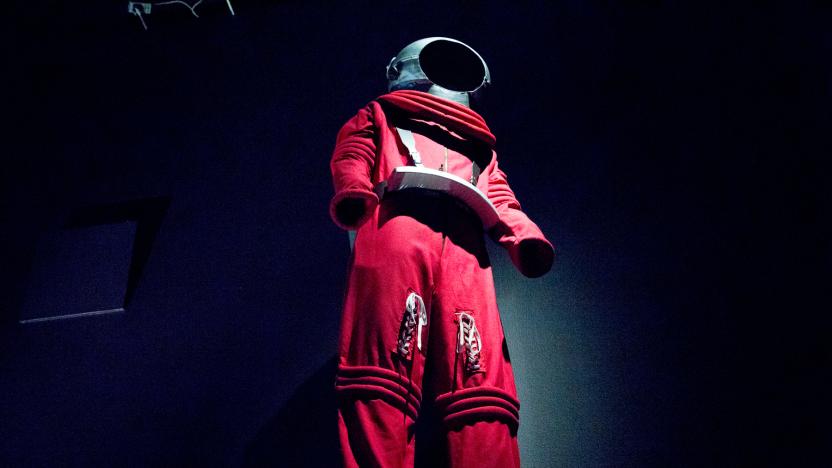interstellar
Latest

Interstellar is coming back to theaters in September for its 10-year anniversary
Paramount announced at CinemaCon this week that Interstellar will be re-released on September 27, 2024 in IMAX 70mm and digital, according to Variety. Christopher Nolan's sci-fi odyssey was first released in fall 2014.

Interstellar is still struggling to put private rockets in space
Japan's young private spaceflight industry has taken another hit as Interstellar's MOMO-5 rocket failed to reach space.

First observed interstellar object is a speedy, cigar-shaped asteroid
Last month, astronomers running the Pan-STARRS 1 telescope in Hawaii spotted an intriguing object moving through our solar system and it became clear pretty quickly that the object, whether it was a comet or an asteroid, had come from outside of our solar system. Now, in a paper published this week in the journal Nature, researchers have described the interstellar visitor, dubbed 'Oumuamua, including its peculiarities as well as its similarities to objects originating in our own solar system.

Researchers observe the first known interstellar comet
To date, every comet humanity has seen inside the Solar System has come from the Solar System, whether it's the Kuiper Belt or the billions of comets believed to make up the Oort Cloud. Now, however, it looks like astronomers might have found a comet of interstellar origin. They've used Hawaii's Pan-STARRS 1 telescope to track C/2017 U1, an object with a very eccentric, hyperbolic orbit (that is, moving quickly enough to escape gravitational pull) that wasn't connected to the Sun. The trajectory suggests that it's a comet which escaped from a nearby star, rather than something knocked out a familiar path and drawn in by the Sun's gravity.

Inside the Barbican’s sci-fi movie wonderland
The best science fiction movies use costumes, models and physical props to sell their vision of the future. Alien, for instance, would be nothing without the compression suits worn by its ill-fated crew outside the Nostromo. From June 3rd, the Barbican Centre in London will be celebrating these movies and the staggering work that went into them through a new exhibition called 'Into the Unknown.' Walk down its dark, curving corridor and you'll find original spacesuits from Alien, Moon, Sunshine and Star Trek, as well as original Darth Vader and Stormtrooper helmets from Star Wars: Episode V The Empire Strikes Back.

What's on your HDTV: 'Interstellar' Blu-ray, 'Mad Men', 'Archer'
The NCAA men's basketball tournament is down to its Final Four, and this weekend we'll find out which two move on to the championship game. Of course, we'll be glued to the couch watching Interstellar on Blu-ray. The film will even bring its IMAX sequences home The Dark Knight-style, pushing black bars aside to fill up the 16:9 screen. On TV, AMC's Mad Men begins to run its final few episodes, while we also have the season finale of Archer on FX. PS4 gamers can check out a new Metroid-ish shooter called Axiom Verge, while on Xbox One the free MMO Neverwinter is launching. Look after the break to check out each day's highlights, including trailers and let us know what you think (or what we missed).

The black hole imagery of 'Interstellar' is helping astrophysics
You may have heard that the representation of a black hole in Interstellar was not only based on real science, but might tackle researchers' problems depicting these gravitational points. Well, that just happened -- physicist Kip Thorne and visual effects outfit Double Negative have published papers detailing the code used to portray the movie's black hole, Gargantua. Rather than trace individual light rays, they followed the paths and shapes of the millions of distorted beams traveling around the hole. The technique eliminates flickering effects that not only wreck your moviegoing experience, but prevent astrophysicists from getting a clear picture of what such a scene would look like in real life.

AMC's unlimited ticket lets you watch 'Interstellar' as much as you want
Are you so enthralled with Interstellar that you're determined to see it a second, third or ninth time? AMC Theatres might have you covered. The chain has just unveiled its first-ever Unlimited Ticket for the sci-fi epic; if you're an AMC Stubs member, you can shell out between $20 and $35 (depending on the location) to come back to the theater as much as you want. If you've already seen the flick, you can plunk down $15 to upgrade. You'll have to watch at least twice for this offering to make sense, but that's not hard if you have friends who want to see the movie after you've already been.

'Interstellar' makes the case for humanity's return to space
Interstellar achieves a rare feat for a blockbuster. Like the best science fiction, it manages to tell a distinctly human story while also holding up a mirror to our societal ills. But it's also a film that isn't afraid to explore real science -- the plot largely hinges on its space-time dynamic, and it does so while plumbing the depths of human sentiment. At its core, Interstellar drives home the idea that we humans are curious creatures, and inherently explorers.

Investigating the science in Christopher Nolan's 'Interstellar'
Even the most well respected filmmakers have been known to bend the truth a bit when it comes to depicting science on the silver screen, throwing accuracy to the wind in favor of trivialities like "plot" and "drama." We kid, of course. But how does this fall's sci-fi epic Interstellar from director Christopher Nolan hold up under a microscope (no pun intended)? The folks at Popular Science have taken the Dark Knight helmsman's latest to task, exploring the feasibility of traveling through wormholes, the type of spaceship we'd need for humanity to travel 'round the stars and a few other concepts explored in the film.

You can get a virtual reality peek at 'Interstellar' in four theaters
You've probably wanted to immerse yourself in a movie's fictional universe at some point. Well, you're about to get your chance -- if you live in the right city, anyway. Theaters in Houston, New York City, Los Angeles and Washington are hosting a virtual reality "first look" for Interstellar that lets you tour the space exploration flick's Endurance ship using an Oculus Rift headset. The experience is available in New York from October 6th through the 8th, and will swing through the remaining three cities over the course of the next two months. You can't watch Interstellar itself in VR, but this will at least give you a peek at another side (or really, many sides) of the sci-fi title that you wouldn't otherwise get. Update (10/8): In case you didn't make it to the demo, there's a video (embedded after the break) to give some idea of what you missed.

NASA's Voyager 1 marks 35th anniversary of its launch, gets photo retrospective in tribute
It's hard to believe at times that the Voyager 1 probe is older than many of us reading this article, but it's true. The official first part of NASA's Voyager program launched just over 35 years ago on September 5th, 1977, carrying not just cameras and sensors to capture the trip but the famous Golden Record documenting humanity for any curious aliens. To mark the occasion, Wired has gathered together one heck of a photo album that covers both Voyager 1's trip as well as that of Voyager 2, which technically launched earlier (August 20th the same year) but took a more roundabout route through the solar system. The gallery reminds us of the amazing scenery beyond Mars and puts our tiny blue ball of a planet in perspective; Earth was just a speck at best when photographed late into Voyager 2's journey. Perhaps the best news surrounding the milestone is simply that both Voyager probes are still running. At 11 billion miles from the Sun, Voyager 1 may be on the cusp of interstellar space and easily represents the most distant human object ever made, not to mention a record-setter for signal transmissions. There's even a chance we'll still be hearing back from the probe for its 50th anniversary -- its power could keep it chatting up to roughly 2025.






